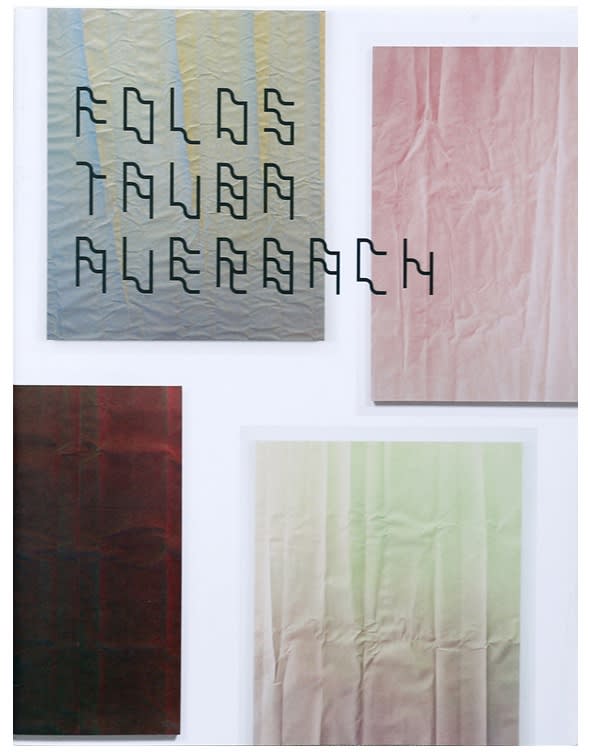TAUBA AUERBACH: "Tetrachromat"
TAUBA AUERBACH
“TETRACHROMAT”
17.03.-10.06.2012 / MALMÖ KONSTHALL, MALMÖ
-----
"Tetrachromat" was initiated by Bergen Kunsthall, and was a collaboration between Malmö Kuosthall and WIELS Contemporary Art Centre, Brussels
Curator: Solveig Øvstebø
In Tauba Auerbach's work traditional distinctions between image, dimensionality and content collapse. Surface, specifically the larger issues surrounding topology, has been a central concern in their recent paintings, drawings, photographs and artist's books. Auerbach interweaves discordant positions such as disorder and order, readability and abstraction, permeability and solidity - phenomena that are usually viewed as incompatible - into unified surfaces and volumes.
The title of the exhibition plays on the notion of 'tetrachromatic' vision. People normally perceive the world around them trichromatically (in three colours). Humans have three types of receptor for the perception of colour with varying sensitivities: red, green and blue. A new theory exists that there may be a small percentage of people (only women) who have a fourth colour receptor, which makes them 'tetrachromatic'. In order to play on such ideas of a fourth component which, if it could be proven, would radically change our view of the world, Auerbach employs two analogies in this exhibition - the spatial (the idea of a fourth dimension) and the spectral (a fourth colour spectrum).
Since 2009, Auerbach has created a body of work they call "fold paintings". Inasmuch as they obscure the boundaries between two- and three-dimensionality, these paintings can be understood as an analogy that raises the possibility of a concept of four dimensions. In these paintings they twist and fold the canvas, ironing or pressing it in such a way that the folds are embedded in the material. Then the canvas is spread out and spray-painted while it still has its three-dimensional contour. The result - after the paint has dried and the canvas has been stretched - is an almost perfect registration of the previous three-dimensional form of the surface. The surface takes on a trompe l'oeil effect as a convincing reproduction of three-dimensional form on a surface, not unlike traditional mimetic painting - but in this case based on inventiveness rather than painterly virtuosity.
Auerbach often works in series where they use both digital and older craft-based methodologies, such as sign painting or weaving - not for nostalgic reasons, but to throw ideas surrounding 'technologies' into relief. So it is perhaps also a natural consequence that they treat painting as a technology on an equal footing with other visual forms of communication - from the cuneiform script of ancient Mesopotamia to digital printing.
The fold paintings relate directly to this way of understanding painting - as a technology where the mechanical qualities that are specific to the medium are exploited, but also force the painting to behave in ways we associate with other technologies. Recalling the photographic process, the painting is 'developed' in the course of the time it takes to spray-paint the surface, in the same way as an image is developed on photographic paper in the chemical bath in the darkroom, or on the film in the camera. Contrasts and contours in Auerbach's paintings are similarly intensified by a longer 'exposure' of the paint on canvas.
Besides developing the series of fold paintings further, Auerbach has produced a whole new series of works for the exhibition at Bergen Kunsthall. In these, they exploit various weaving techniques where the canvas is cut into strips, only to be woven together again in a series of different patterns designed by the artist herself. Instead of presenting spatiality by means of colours, they build up the surface through pure structure and form. In these works Auerbach takes their point of departure in the corner figure which is precisely a precondition of three-dimensionality.
Tauba Auerbach has long worked with different types of book production. Recently these have developed into independent sculptural works that continue Auerbach's research on multidimensionality and the importance of colour for spatiality. They present several new book sculptures in this exhibition, and in a way these function as manuals for thinking about the project by constantly revolving around the question "How can we imagine what is impossible to sense?"
Although Auerbach draws much of their inspiration from mathematics and physics, their visual investigations deal equally with the basic themes of art history. Their paintings raise fundamental issues in new ways, among them the depiction of three-dimensional reality on a two-dimensional surface, and the relationship between abstraction and representation.
-----
Installation photography: Vegard Kleven


